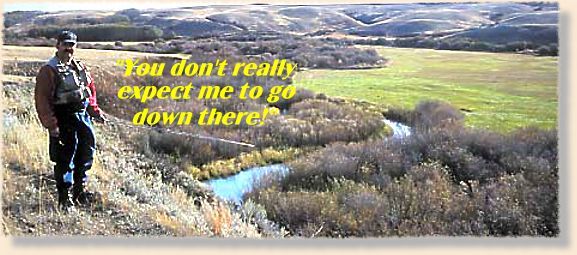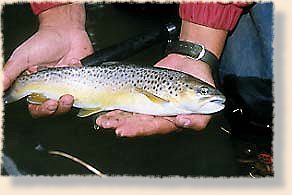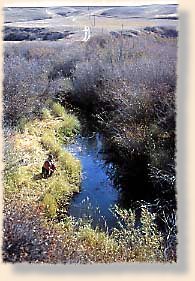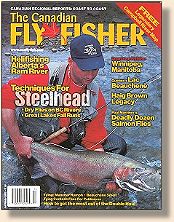Saskatchewan
The Southwestern Trout Streams, Part 1
Text and Photos by Bob Sheedy

I studied Rick Goett's inscrutable features to see if he was serious, but as usual he was
unreadable.
We were standing on the edge of a cut bank above the broad valley that contained Belanger
Creek. I eyed the precipitous descent to the bottom and across to where we had fought
underbrush and caught Brook Trout throughout the morning. I glanced back at the willows
rimming either side of the watercourse we had just left, and knew why we had forsaken the
impenetrable thatch in favor of the meadow that now led to our current lofty perch. Far below
us a beaver dam promised the first open water I'd seen that day, without strangling from a
willow branch as I attempted to drag a fly rod through the maze. However, to fish the new
water that held much larger trout than the tiddlers we'd caught so far, we would have to
plunge down this hundred foot cut bank to stand on nothing, as the slope apparently entered
the water without ledge or interruption.
"So how do I get stopped once I start to slide?"
"Don't slide! But if you do go in, it's only about ten feet deep."
I turned back to Rick's gun-sight eyes, trained by his long association with law enforcement
and dealing with malefactors.
"You're serious!"
With one last look down the cut bank and at the prickly handholds strung sparsely
down its face, I took the plunge. I half-climbed, half slid until I was a good way down
and then paused to photograph Rick's descent and to withdraw some spines from my
hand when I arrested an overzealous slide by mistakenly grabbing a prickly pear.
"Oh, Bob. I forgot to tell you. Keep a sharp eye for rattlesnakes. In the fall, they love
these holes in the bank where it faces the sun."
"Oh great!" This was the sunny side, warm for late October, and the obvious choice for
any slithery critter. Moreover, the slope was infested with potential hidey-holes, any one
of which could easily harbor a full-grown reticulate python. But there was little need for
worry. As a prairie boy, I knew that rattlers have become an endangered species in
Southwestern Saskatchewan.
I was soon at the bottom, kicking a precarious toehold into the bank where it met the water.
A small game trail allowed me to fish the quiet pool beneath and avoid becoming a temporary
resident of it. Rick joined me and offered several suggestions, for a client he had brought here
the previous fall had landed a four-pound brown from the pool. I looked around and then
decided on a casting strategy. Roll-casting was out, for the lack of wind ripples would fail
to hide the line activity, and back casting was impossible due to a vertical expanse of
buck-rush and prickly pear on the bank behind me. Finally, I decided to steeple cast,
and tried some slower retrieves with the nymphs that I had tied for the trip, but with
no response.
"They're spawning," Rick reminded me. "They're not acting like normal." He was right:
late October was not an auspicious time to pursue browns and brookies the
predominant species of the Southwest, but the weather was so wonderful that one
simply couldn't pass up the opportunity. But later, I discovered a cow trail that lead
down to the water and found I could wade a little with a few inches of my chest waders
still above the surface provided I avoided the meticulously camouflaged beaver runs.
I landed four sizable browns and tangled with several more that simply didn't hook.
One of these which followed the fly in twice would have easily made 18 inches, which
is stunning in a creek as small as Belanger.
The Hills
 The Cypress Hills are a paradox. Even their geology shares that of the distant Rockies
and the aboriginal name of the 'Hills that shouldn't be' seems to fit. They are exquisitely
crowned with lodgepole pine, another species transplanted naturally from the Rockies.
The scenery and vistas are something seen nowhere else. Driving along the Ridge north
of Fort Walsh, one looks north into the fertile fields of Saskatchewan and South across
open rangeland far down into Montana. This is a place of history, a place where the native
and Hivervant Canadians traveled to winter and hunt the elk, moose and bison that wintered
in the region. This is where many of the Métis fled to avoid persecution after the failed
Northwest Rebellion. When one fishes Battle Creek, in the area between the Equestrian
Campground and Fort Walsh, one can imagine the weary members of the North-Western
Mounted Police returning from patrol as they shut down the activities of the American
whiskey traders.
The Cypress Hills are a paradox. Even their geology shares that of the distant Rockies
and the aboriginal name of the 'Hills that shouldn't be' seems to fit. They are exquisitely
crowned with lodgepole pine, another species transplanted naturally from the Rockies.
The scenery and vistas are something seen nowhere else. Driving along the Ridge north
of Fort Walsh, one looks north into the fertile fields of Saskatchewan and South across
open rangeland far down into Montana. This is a place of history, a place where the native
and Hivervant Canadians traveled to winter and hunt the elk, moose and bison that wintered
in the region. This is where many of the Métis fled to avoid persecution after the failed
Northwest Rebellion. When one fishes Battle Creek, in the area between the Equestrian
Campground and Fort Walsh, one can imagine the weary members of the North-Western
Mounted Police returning from patrol as they shut down the activities of the American
whiskey traders.
The Streams
 Of the streams in Saskatchewan's Southwest, only Bear Creek and the Bone flow north,
the latter to Lake Deifenbaker via the Swift Current River. Although the Bone hosts the
largest trout in the region, the willow choked stream, which flows into the Swift Current
River, retains them only in its upper reaches. The Bone receives little pressure, being
somewhat out of the way. Dave Whitlock fished it in 1998 and referred to it as "challenging"
for it is deep, swift and all but unapproachable through willow banks which enforce the
dapping techniques we practiced on Belanger Creek, south of the beaver dammed areas.
The Cypress Hills form the height of land that directs all the remaining streams to Montana's
Milk River, mainly by way of the Frenchman River. All streams find their genesis in springs
flowing from the loose matrix, which forms the geology of the Hills. That explains their
gin-clear characteristics and pristine water quality. It also makes for spooky fish that
require extreme caution when negotiating banks and approaching casting stations.
Of the streams in Saskatchewan's Southwest, only Bear Creek and the Bone flow north,
the latter to Lake Deifenbaker via the Swift Current River. Although the Bone hosts the
largest trout in the region, the willow choked stream, which flows into the Swift Current
River, retains them only in its upper reaches. The Bone receives little pressure, being
somewhat out of the way. Dave Whitlock fished it in 1998 and referred to it as "challenging"
for it is deep, swift and all but unapproachable through willow banks which enforce the
dapping techniques we practiced on Belanger Creek, south of the beaver dammed areas.
The Cypress Hills form the height of land that directs all the remaining streams to Montana's
Milk River, mainly by way of the Frenchman River. All streams find their genesis in springs
flowing from the loose matrix, which forms the geology of the Hills. That explains their
gin-clear characteristics and pristine water quality. It also makes for spooky fish that
require extreme caution when negotiating banks and approaching casting stations.
Among these, Boiler, Sucker, Belanger, Caton Creeks and the main Frenchman River
remain popular with visitors to the nearby Inter-Provincial Park. Visitors to East End,
Saskatchewan favor Conglomerate and Calf Creeks. Battle Creek originates in Alberta
and flows independently, south into Montana. It remains my personal favorite, although
the Bone and Frenchman are the big fish rivers, both capable of producing double digit trout.
However, big fish were not the charm that drew me to the area originally. Rather I was,
and continue to be, haunted by clear streams, spilling down stony slopes, around roots,
undercut banks and protected by underbrush that turn away all but the dedicated soul.
Short of the Saskatchewan's Cub Hills, Western Alberta and certain former haunts in
Ontario, I know no other place such as these waters.
Stocking has been practiced in one form or another since the '20's, but modern egg baskets
and stockings from the Qu'pelle hatchery ensure good numbers of fish for the few fly-fishers
who have discovered the regional opportunities. The stocking and re-habilitation programs,
largely promoted and instituted under Rick Goett, my guide for the occasion, have been very
successful, although the area had been left largely "undiscovered".
Except for stretches of the Boiler and Battle Creeks, all waters flow through private land
and require landowner permission for access and certain protocols with gates and less
obvious items, such as not parking in grass where a vehicle's catalytic converter could
inadvertently destroy thousands of acres of rangeland. This is open range and although
fenced one quickly gets used to the idea that both cattle and mule deer more common
than traffic signs along and upon the lightly trafficked roadways. However, once people
realize that one is a fly fisher, who returns the trout to the stream, and is knowledgeable
of the rancher's concerns, access is easily gained. An example of this was at Conglomerate
Creek when the landowner specified that we not approach the redds where the browns
were currently spawning. We obeyed and were invited back, "anytime".

The key to the area is Cypress Hills Inter-Provincial Park, hidden away in two blocks
of the Hills and providing some of the best camping found anywhere. They are joined
by a road "negotiable only in dry seasons". While the East Block has the best family
camping, I prefer the primitive campsites gracing the banks of Battle Creek. Fishing
begins ten feet from your tent and June hatches might awaken one to the sound of rising
trout. It is a free stone stream rimmed with fragrant Lodgepole Pine, and comprised of
riffles, runs and deep pools that harbor browns and Brookies, some of considerable
dimensions as I discovered in the pool just above the ranger station bridge. A silvery
form followed my second cast and snatched the fly from the tippet as I lifted it out of
the pool. ~ Bob Sheedy
Concluded next time!
|



